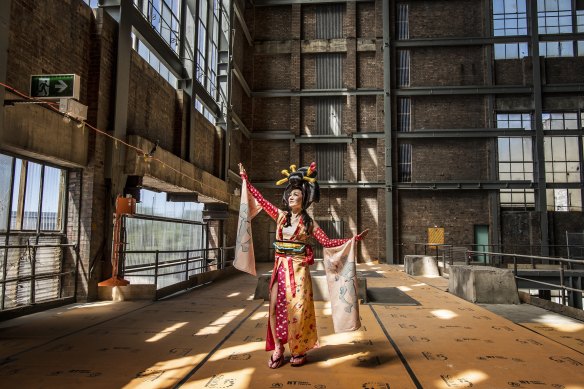This once-derelict Sydney building is ‘better than Tate Modern’, say curators

Save articles for later
Add articles to your saved list and come back to them any time.
With its soaring light-drenched halls, and redundant steam-driven machinery, Sydney’s old White Bay Power Station has the drama and scale of London’s Tate Modern but better, say the international curators whose job it is to fill its industrial halls with contemporary art.
The vast historic site, which once powered the city’s tram network, opens its doors in March to the public for the first time in 100 years when the 24th Biennale of Sydney stages three months of free events. It was shuttered as a workplace 40 years ago.
Japanese Artist Maru Yacco inside White Bay. Credit: Steven Siewert
A life-size television set, a mural celebrating an Indigenous Sydney Mardi Gras pioneer, a neon light installation inspired by the Rainbow Serpent, and a program of musical performances are all part of the festival’s plans to breathe creative life into White Bay.
Unveiling next year’s program, Biennale’s co-curator Inti Guerrero, says the building’s history-soaked walls, made White Bay a particularly theatrical backdrop for the Biennale, Sydney’s largest celebration of contemporary art.
“Exhibitions are more than just a sum of what is inside them,” Guerrero says. “This building is much more interesting [than Tate Modern] because there are these leftovers of the archaeology of the carbon era that play in the space in artistic ways.”
More than $100 million has been invested in White Bay’s restoration and remediation to rid it of asbestos, lead dust, and pigeon droppings, and replace rusting metalwork and broken glass.
Unlike Tate Modern – the world-leading museum repurposed from a power station on the banks of the Thames River – White Bay bears signs of its working life before it was shuttered in 1983. The building retains its coal conveyor, one of four boilers, hoppers, and one of four original steam turbines.
The Boiler House rises eight storeys and the Turbine Hall six storeys. Internally, White Bay is about one and a half times the size of the Queen Victoria Building and larger than Tate Modern itself.
The control room is a scene “straight out of Chernobyl”, says Inner West Mayor Darcy Byrne whose council campaigned to stop the building’s demolition.
“The whole of the inner west community is going to be camped out down here when they see this incredible program,” he said. “This is the start of White Bay becoming one of the great arts and cultural venues across the world.”
Placemaking NSW’s chief executive, Anita Mitchell said White Bay was similar in form but maybe not in function to Tate Modern.
“We have not decided what kind of art and cultural space Sydney needs; that’s what we will determine over the next year as we trial different events and activations. We want to make sure this adds to the cultural landscape of Sydney rather than competing with what’s already there.”
Biennale’s co-artistic director, Cosmin Costinaș says White Bay will take visitors back in time to a world of industry and labor.
“You can feel the massive efforts that were made by the working class at the time to create the electricity that powered Sydney’s tram network.” The building’s natural light was “better than the Tate”.
The building’s role as a fossil fuel generator feeds into the Biennale’s broad curatorial theme of, Ten Thousand Suns, which dips into the impact of climate change and disruptions of the atomic age. But the curators promise to mix politics with a vision of the future lived with hope and pops of joy.
Next year’s edition will feature 88 artists and collectives from 47 countries including Australia, Indonesia, Brazil, Ukraine, the United States, Britain, New Zealand, India, and Japan.
The public will be welcomed back to White Bay with Lights On, an opening night party featuring an outdoor stage, roving performers, bars, and an indoor electronic dance floor. The powerhouse’s old furnaces will be at the epicentre of its music show.
For the 13 weeks of the Biennale White Bay will open Wednesdays and Thursdays until 9pm for a program of art after-dark entertainment.
Installations for White Bay include a large-scale mural celebrating the life of First Nations dancer and activist Malcolm Cole, who led the first Aboriginal float at the 1988 Sydney Gay and Lesbian Mardi Gras Parade by Yuwi artist Dylan Mooney.
Inside the Boiler House, leading Indigenous artist Kaylene Whiskey is building a giant television set containing superhero figures.
At the southern end of the Turbine Hall, Darrell Sibosado will present a neon work representing the detached scales of Aalingoon, the Rainbow Snake.
As well as White Bay, the Biennale will present at the Art Gallery of NSW, the Museum of Contemporary Art Australia, the newly refurbished Artspace, and for the first time at Chau Chak Wing Museum at the University of Sydney, and the UNSW Galleries.
Find out the next TV, streaming series and movies to add to your must-sees. Get The Watchlist delivered every Thursday.
Most Viewed in Culture
From our partners
Source: Read Full Article
